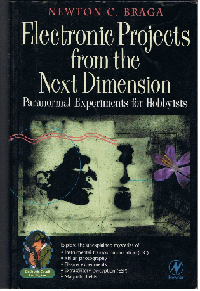Shakespeare was confident When writing “There are more things in heaven and earth, Horatio, Than are dreamt of in your philosophy” (Hamlet) and, even in our time, despite the fantastic progress of “official science,” there are many more unexplained things in our world than our philosophy can dream.
Many people believe that “ofñcial science” is not relevant to “paranormal phenomena,” leaving the subject to mystical groups, religious groups, amateur scientists, and others.
They are wrong. Each day, paranormal phenomena become more evident, and we cannot deny their existence. Little by little, these phenomena are being recognized as legitimate targets of ofñcial science.
Important research organizations such as universities, government organizations, and others are forming groups to work in what is referred to as paranormal sciences, including ESP (extra-sensory perception), EVP (electronic voice phenomena), ITC (instrumental transcommunication), poltergeists, telepathy, µFOs, and so on, in a clear admission that they believe in an old adage of my country, “Where exists smoke also exists fire.”
Today, the groups are multiplying, and many are devoted to speciñc areas of research with paranormal phenomena.
Most of these groups are motivated by a strong sense of curiosity and are trying to develop new experiments and theories.
In many cases, they are trying to adapt the results of their work to fit their beliefs (religious or philosophical).
As the fundamentals of paranormal sciences are not included in the standard curriculum of our schools, anyone who wants to perform his own experiments will discover that there ís a large barrier to traverse.
There are few sources of information about scientific techniques and procedures that are suitable for practical experiments. There are no “oficcial” methodologies to be used in a specific endeavor with those kinds of phenomena.
And, what is more important to us, descriptions of practical instruments and devices that can be used for this research are rare. The consequences for readers who want to conduct work in this field are easy to see:
A great deal of improvisation is required.
Because of an absence of scientiñc information, it is difñcult to separate what is real from what is false.
There is a great lack of knowledge in using high-technology devices-and even common home appliances such as computers, microprocessors, and basic electronics.
Notice that when we use the term high technology, we are referring to electronics. This science offers vast resources to researchers in all scientiñc ñelds, which of course is not limited to paranormal phenomena. (What lab doesn’t perform measurements with electronic instruments?)
In the process of giving support to groups of researchers, the author has found that many practical (and sometimes simple) electronic circuits can be used when making serious experiments involving paranormal phenomena.
And some of the circuits are indeed simple many can be assembled even by amateurs in a single weekend.
This section is a large collection of circuits that the author has recommended to many researchers, curious individuals, and hobbyists during more than 30 years of work as technical director and author for two important electronics magazines in Brazil.
Many of the circuits have been described in these magazines with objectives other than paranormal research, but the author has found it easy to make modiñcations for this task, and those modiñcations have been included in the projects included in this section.
To make it easy for the “common reader and researcher” to assemble the projects described in this section, the circuits have been simple and use only common parts.
Many can even be found in old non-functioning devices such as radios, amplifiers, TV sets, etc. The circuits are not critical in design, which allows the reader to try his own modiñcations for increasing performance and/or changing the basic aim. In addition, the author invites readers to make alterations in the circuits (at indicated points) to broaden the range of applications.
The author also has included basic technical information about each project.
Explaining how each circuit works makes it easier for the researcher to conduct the experiments correctly and safely. It also makes it easier to separate incorrect conclusions about what is happening from reality.
Finally, the author wants to remind readers that he intends only to give them the tools to conduct research work with paranormal phenomena. The resultsexplanations and theories about the nature of the phenomena-are left to the reader. But the author does not want to be disengaged from such matters.
He invites readers to write him and tell about their results. Your discoveries may even point the direction for the articles in this site.




